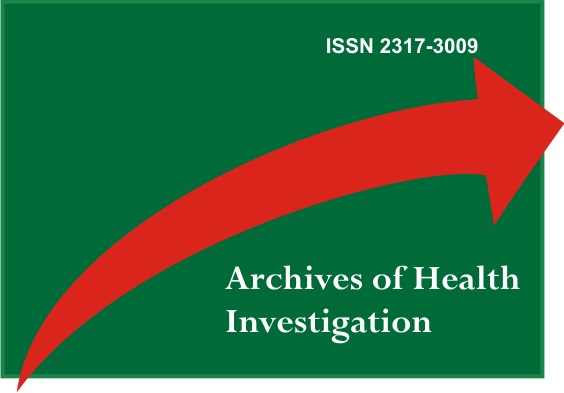Use of Invisible Removable Aligners in the Mixed Dentition: a Literature Review
DOI:
https://doi.org/10.21270/archi.v11i5.5877Keywords:
Removable Orthodontic Appliances, Mixed Dentition, Clear AlignersAbstract
Introduction: Removable clear aligners were indicated to treat light or moderate crowding, in addition to closing small spaces with aesthetics, comfort and facilitated hygiene. However, as the research on the system advances, it is possible to treat more complex malocclusions and in mixed dentition. Objective: Review the literature on the use of removable clear aligners in mixed dentition. Methodology: This is a literature review searching in 6 different databases using the descriptors “Orthodontic Appliances, Removable”, “Dentition, Mixed” and alternative terms. Results: Of the 119 articles, 7 were selected to compose this review following the inclusion and exclusion criteria. Literature Review and Discussion: In the mixed dentition phase, there is agreement among the studies in reporting cases of use of removable clear aligners with the objective of maintaining and recovering space, correction of crowding, mild expansion of the maxillary arch, correction of anterior crossbite, deep bite correction, mild class II and III correction. The aligner exchange protocol ranged from 3 to 14 days, using 4 to 127 aligners. Conclusion: Most articles report the use of systems from the company Align Technology. Accessories for aligners expanded the possibilities with aligners being used in all reported malocclusions, while complementary orthodontic appliances were rarely reported. It can be considered a promising orthodontic alternative in the treatment of certain malocclusions in mixed dentition, however observational studies with larger samples and randomized clinical trials are needed to determine the results.
Downloads
References
Barone S, Paoli A, Razionale AV, Savignano R. Computational design and engineering of polymeric orthodontic aligners. Int J Numer Method Biomed Eng. 2017;33(8):e2839.
Meazzini MC, Tortora C, Cohen N, Mazzoleni F, Balbo N, Donati V, et al. Comparison of the psychosocial impact on patients affected by cranio facial anomalies between traditional orthodontic brackets and aligners. Int J Adolesc Med Health. 2020;34(5):357-65.
Hennessy J, Al-Awadhi EA. Clear aligners generations and orthodontic tooth movement. J Orthod. 2016;43(1):68-76.
Mihailescu A, Labunet A, Muntean A, Kui A, Campian RS. Psycho-social impact of orthodontic treatment in Romanian teenagers and young adults. Clujul Med. 2018;91(3):336-41.
Tai S. Técnica de Alinhadores Invisíveis. Editora Napoleão; 2019.
Kravitz ND, Kusnoto B, Agran B, Viana G. Influence of attachments and interproximal reduction on the accuracy of canine rotation with Invisalign. A prospective clinical study. Angle Orthod. 2008;78(4):682-87.
Galan-Lopez L, Barcia-Gonzalez J, Plasencia E. A systematic review of the accuracy and efficiency of dental movements with Invisalign®. Korean J Orthod. 2019;49(3):140-49.
Kreia TB, Bittencourt Neto AC de, Retamoso LB, Santos-Pinto A dos, Tanaka O. Tendência de crescimento facial em Ortodontia e Ortopedia Funcional dos Maxilares. RGO Rev Gaúch Odontol. 2011;59:97-102.
Blevins R. Phase I orthodontic treatment using Invisalign First. J Clin Orthod. 2019;53(2):73-83
Abraham KK, James AR, Thenumkal E, Emmatty T. Correction of anterior crossbite using modified transparent aligners: An esthetic approach. Contemp Clin Dent. 2016;7(3):394-7
Haubrich J, Schupp W. Invisalign treatment in early years to avoid potential extraction treatments -case reports. J Aligner Orthod. 2018;2(1):39-52.
Haubrich J, Schupp W. Treatment in early years to avoid potential extraction treatments - A case report. [Internet]. KVM - Der Medizinverlag. 2019:377-85.
Staderini E, Meuli S, Gallenzi P. Orthodontic treatment of class three malocclusion using clear aligners: A case report. J Oral Biol Craniofac Res. 2019;9(4):360-62.
Staderini E, Patini R, Meuli S, Camodeca A, Guglielmi F, Gallenzi P. Indication of clear aligners in the early treatment of anterior crossbite: a case series. Dental Press J Orthod. 2020;25(4):33-43.
De Zotti FE, Iaracitano B, Gazzotti ML, Basílico C, La Valle MG. Alineadores como recurso terapéutico en primera fase Aligners as a therapeutic resource in the first phase. Ortodoncia. 2020;84(167):110-19.
Levrini L, Carganico A, Abbate L. Maxillary expansion with clear aligners in the mixed dentition: A preliminary study with Invisalign® First system. Eur J Paediatr Dent. 2021; 22(2):125-28.


